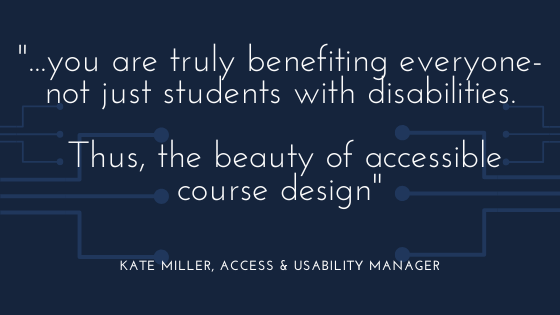Rethinking Accessibility and Student Experience During COVID-19

When the COVID-19 crisis shut down on-campus courses this spring and forced all classes into a “remote” or online format, I saw an outpouring of faculty who moved their courses to a remote format with dedication and determination. It was crisis mode, and faculty did not back down from the challenge. As we settle into our new “normal” and look ahead to a summer of online and remote courses, I’ve begun to reflect on what we’ve learned and seen during this spring semester about accessibility and success for students in remote classrooms.
Many instructors may already be aware of the need for improved accessibility in online courses, especially with lawsuits that have sprung up during recent years. Even at CU Denver and Anschutz, last year’s Campus Policy 5012 highlighted the need to improve access to our digital content for students with disabilities or different learning preferences. Some already recognize that captioning videos or providing alternate text for images are best practices for creating accessibility in course content. But what more can we learn about student access and course design from the situation brought on by COVID-19?
During recent months, I’ve been fortunate to sit in on regular meetings with campus leaders in disability services and resources for students, and I began to rethink what “accessibility” truly means for our online or remote students, especially right now. A few anecdotes stand out in my mind, such as the student struggling in the current remote-learning format because they can’t watch a computer screen for more than 20 minutes without succumbing to a migraine. Or students who don’t have reliable internet at home, and no longer have the library or coffee shop wi-fi available as an alternate work space. Or, as some of us know all too well, the best-laid plans of a distraction-free zone in our home to attend a Zoom session is often interrupted by our children’s needs.
I recently asked Kate Miler, Access and Usability Manager in the Office of Information Technology, what advice she has for faculty during this unprecedented time of online and remote course delivery, and through the lens of accessibility and barrier-free learning. Kate recommends that "while this is an unprecedented time, I also think this is a time of great opportunity. When creating course content that is accessible, you are truly benefiting everyone - not just students with disabilities. Thus, the beauty of accessible course design. You do not need to start over from a design perspective, but rather look at implementing small changes and easy wins that will help remove barriers for all students. For example, caption your videos, describe the images in your course, use headings, and ‘chunk up’ your text for easier comprehension. There are great resources available to help in this effort - you are not alone!" (As Kate mentions, there are a variety of resources out there and I’ve included some of them at the bottom of this post).
As another great perspective and further reading, Lisa McGill (Director of the Disability Resources & Services office for the Denver and Anschutz campuses) shared a recent blog post with me written by a faculty member at the City University of New York (The Single Most Essential Requirement in Designing a Fall Online Course by Cathy Davidson). As Lisa pointed out, “It’s a good reminder about the concepts of trauma, humanity and the impact this has with our currently learning environment.” I couldn’t agree more, and it’s encouraging to see this perspective on teaching and course design during this trying time.
So, what does accessibility truly mean for our students? I think it can be equated with compassion. Compassion to put it upon ourselves as instructors and designers to open up our course content and allow students to access it when they can, and when it’s safe and healthy for them to. Compassion to remove barriers to our students’ learning. Short recorded lectures, asynchronous discussions, access to slides/handouts/materials with plenty of time for review, flexible deadlines, untimed exams, etc. All of these considerations for our students demonstrate compassion and make courses more accessible, which in turn sets our students up for success.
At the end of the day, these are simply my own thoughts for improvement. I’d encourage all of us to take a moment to reflect and consider, what does this look like in your own course? What are your own experiences in teaching with compassion, and making your course(s) more accessible? And what valuable insight can we share with each other as we navigate this new “normal”? Moving forward, we don’t yet know how the COVID-19 pandemic will impact our face-to-face courses and how we continue to offer courses in the future. But, we can learn from the current scenario and learn from our students’ stories and our own experiences. We can continue to practice compassionate teaching (long after the pandemic is over), and continue the iterative process of improving the learning experience for our students.
If you’re interested in exploring additional resources for accessibility and universal design for your students, check out some of these great options:
CU Denver/Anschutz Disability Resources & Services
Office of Information Technology - Accessibility Resources
20 Tips for Teaching an Accessible Online Course
Rubric for Inclusive Pedagogy Framework
Inclusive Remote Teaching and Equitable Access for Remote Learning






Add new comment